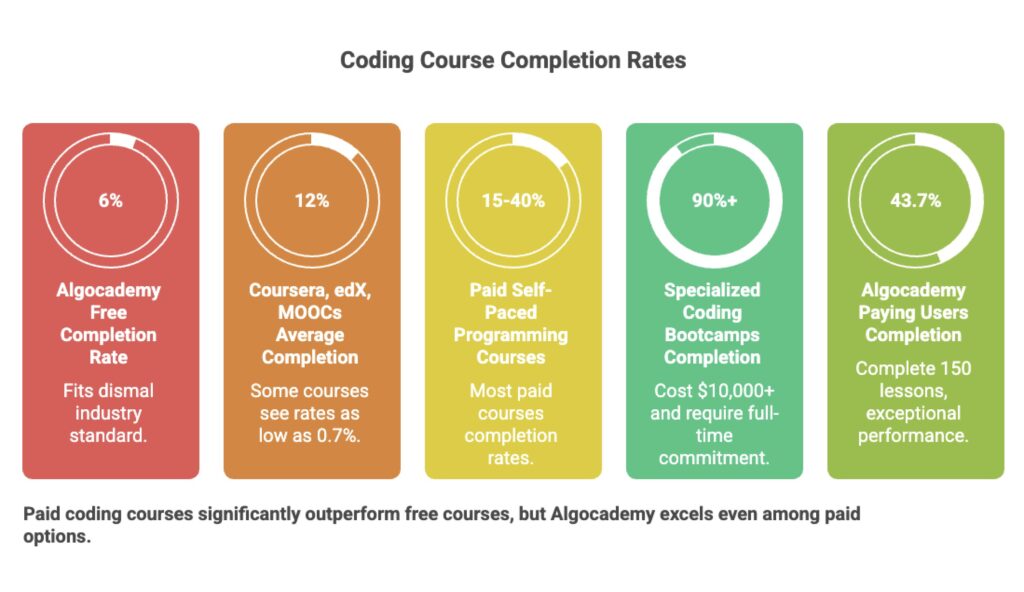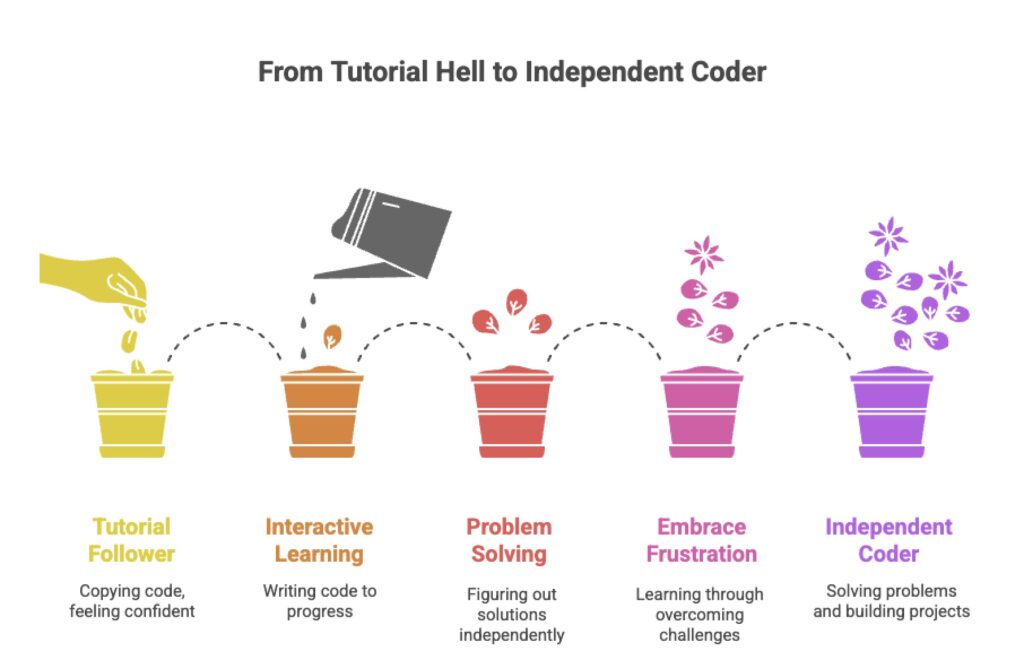Why Paying to Learn to Code Makes You 7x More Likely to Finish

Only 6% of people finish free coding courses. I know because I’ve watched thousands try and quit on Algocademy’s free lessons. But something weird happens when people pay: suddenly 43.7% finish. That’s not just better. That’s a completely different person.
People who pay to learn coding are seven times more likely to actually finish than those who use free resources.
I know what you’re thinking. “Of course people who pay finish more often. They have skin in the game.” And you’re right, but the numbers tell a more interesting story than simple financial commitment.
At Algocademy, we give everyone access to 17 consecutive free lessons. These aren’t throwaway intro slides. They’re real, interactive coding lessons where you write actual code. But only 6% of people who start these free lessons complete all 17.
Meanwhile, 43.7% of our paying customers finish the full fundamentals course, which is 150 lessons. That’s not just a small bump. That’s a completely different outcome. And when you look at what’s happening across the coding education industry right now, especially with the rise of AI-powered “vibe coding,” this difference matters more than ever.
The Free Course Completion Crisis
Let’s zoom out for a second. The online education world has a dirty little secret that everyone knows but nobody wants to talk about: most people never finish what they start.
Free coding courses see completion rates between 5% and 15%. That’s been consistent across platforms for years. Coursera, edX, and the massive open online courses that were supposed to democratize education? They average around 12% completion, with some courses seeing rates as low as 0.7%.
Our 6% free completion rate actually fits right into that dismal industry standard. But here’s where it gets interesting: even paid courses don’t usually perform that well. Most paid self-paced programming courses see completion rates between 15% and 40%. Some specialized coding bootcamps with selective admissions hit 90%+ completion, but those cost $10,000+ and require full-time commitment.
So when 43.7% of Algocademy’s paying users complete 150 lessons, that number isn’t just good. It’s exceptional. We’re outperforming most paid coding courses while being more affordable and flexible than bootcamps.
Why? Two reasons: payment creates commitment, but more importantly, our teaching method actually works.
Interactive Learning vs. Watching Videos
There’s a reason Algocademy doesn’t rely on video tutorials. Research shows that microlearning and interactive content leads to 17% more effective retention than traditional lecture-based learning. But the real world results are even more dramatic.
Think about the typical “learn to code” journey. You watch a six-hour YouTube tutorial. You follow along, typing what the instructor types. Everything works. You feel like you get it. Then you try to build something on your own and your mind goes blank.
This is what developers call “tutorial hell,” and it’s been plaguing self-taught programmers for over a decade. You can follow tutorials all day long but never develop the ability to solve problems independently.
Interactive, step-by-step coding tutorials solve this problem by forcing you to think. Every lesson on Algocademy requires you to write code to progress. Not copy and paste. Not watch someone else do it. You have to figure it out, even if that means getting stuck and working through the frustration.
That friction? That’s where learning happens.
The Vibe Coding Trap
Now let’s talk about the newest threat to actually learning how to code: vibe coding.
If you haven’t heard this term yet, you will soon. Andrej Karpathy, the co-founder of OpenAI, coined it earlier this year to describe a new way of building software: you tell an AI what you want, and it writes all the code. You never actually look at the code. You just keep prompting the AI until the app works.
It sounds incredible, right? Build apps without learning to code! Just describe what you want in plain English and boom, you’re a developer.
Except you’re not.

Here’s what the research is finding: vibe coding is creating a generation of people who can generate code but have no idea how it works. And when that code breaks (which it will), they’re completely helpless.
A Purdue University study found that ChatGPT’s code solutions were incorrect 52% of the time. Think about that. You’d be better off flipping a coin. And even when the code works initially, 67% of developers report spending more time fixing AI-generated code than they would have spent writing it themselves.
The security implications are even scarier. Studies analyzing AI-generated code found that up to 40% of queries are vulnerable to SQL injection attacks. AI assistants frequently implement security checks on the client side instead of the server, creating massive vulnerabilities that beginner developers don’t even know to look for.
But the worst part isn’t the bugs or security holes. It’s the learning gap.
Research on students using AI coding tools found something disturbing: they could complete programming assignments with AI assistance, but when tested on similar problems without AI, they couldn’t solve them independently. The AI had done the thinking for them, and they never developed foundational problem-solving skills.
One study put it bluntly: “Over-reliance on AI tools hinders foundational learning, especially for beginners.” Another found that students using AI tools showed reduced engagement in key self-regulated learning processes like reflection and self-evaluation, leading to what researchers called “metacognitive laziness.”
Translation: vibe coding makes you dependent on AI instead of teaching you to think like a programmer.
Why Writing Code With Your Own Hands Matters
There’s a reason surgeons don’t learn surgery by watching AI perform operations. There’s a reason pilots spend hundreds of hours in flight simulators before touching real controls. And there’s a reason the best programmers all have one thing in common: they’ve written thousands and thousands of lines of code themselves.
Real learning happens when you’re stuck. When you’re frustrated. When you have to actually think through a problem instead of asking an AI to solve it for you.
One developer who studies coding education put it perfectly: “Tutorial hell allowed you to avoid discomfort by watching someone else code. Vibe coding hell lets you avoid discomfort by having AI write code for you. Real learning happens when you’re stuck, frustrated, and most importantly forced to problem-solve. That’s how your human neural network is rewired.”
This is exactly why Algocademy’s approach works. Every lesson forces you to write code. Not read code. Not watch code being written. Not prompt an AI to write it. You have to think through the logic, type it out, debug your mistakes, and understand why it works.
Is it harder than vibe coding? Yes. Does it take longer? Yes. But here’s the thing: you actually learn.
And that’s why 43.7% of people finish our fundamentals course compared to the 6% who complete the free lessons. The free lessons let people dabble. They can quit anytime with no loss. But paying customers commit, and our interactive method ensures that commitment turns into actual skill development.

The Bottom Line
The data tells three clear stories:
Financial investment drives commitment. People who pay for education take it more seriously. That’s not controversial, it’s just human nature. But payment alone isn’t enough, which is why so many paid courses still see terrible completion rates.
Interactive learning beats passive consumption. You can’t learn to code by watching videos any more than you can learn to play guitar by watching concert footage. You have to actually do the thing, make mistakes, get frustrated, and work through problems.
Understanding beats generation. AI can write code faster than you. It can probably write better code than you (at least at first). But if you don’t understand how the code works, you’re not a developer. You’re just someone who’s good at prompting AI. And when the AI inevitably produces broken, insecure, or unmaintainable code, you’ll be stuck.
This is why that 7x difference matters. It’s not just about completion rates. It’s about whether people actually learn to code or just learn to use AI as a crutch.
At Algocademy, we’re betting on real learning. Step-by-step interactive lessons that force you to think. Problems that challenge you. Feedback that guides you without doing the work for you. And a pricing model that ensures people actually commit to the process.
Because here’s what we’ve learned after teaching thousands of people to code: the ones who succeed aren’t the ones who find the easiest path. They’re the ones who do the hard work of actually understanding how programming works.
You can’t vibe code your way to being a real developer. But you can learn, line by line, problem by problem, until coding becomes second nature.
That’s what our 43.7% completion rate represents. Not just people finishing a course, but people becoming programmers.

Ready to join the 43.7%? Start your first interactive lesson on Algocademy.

